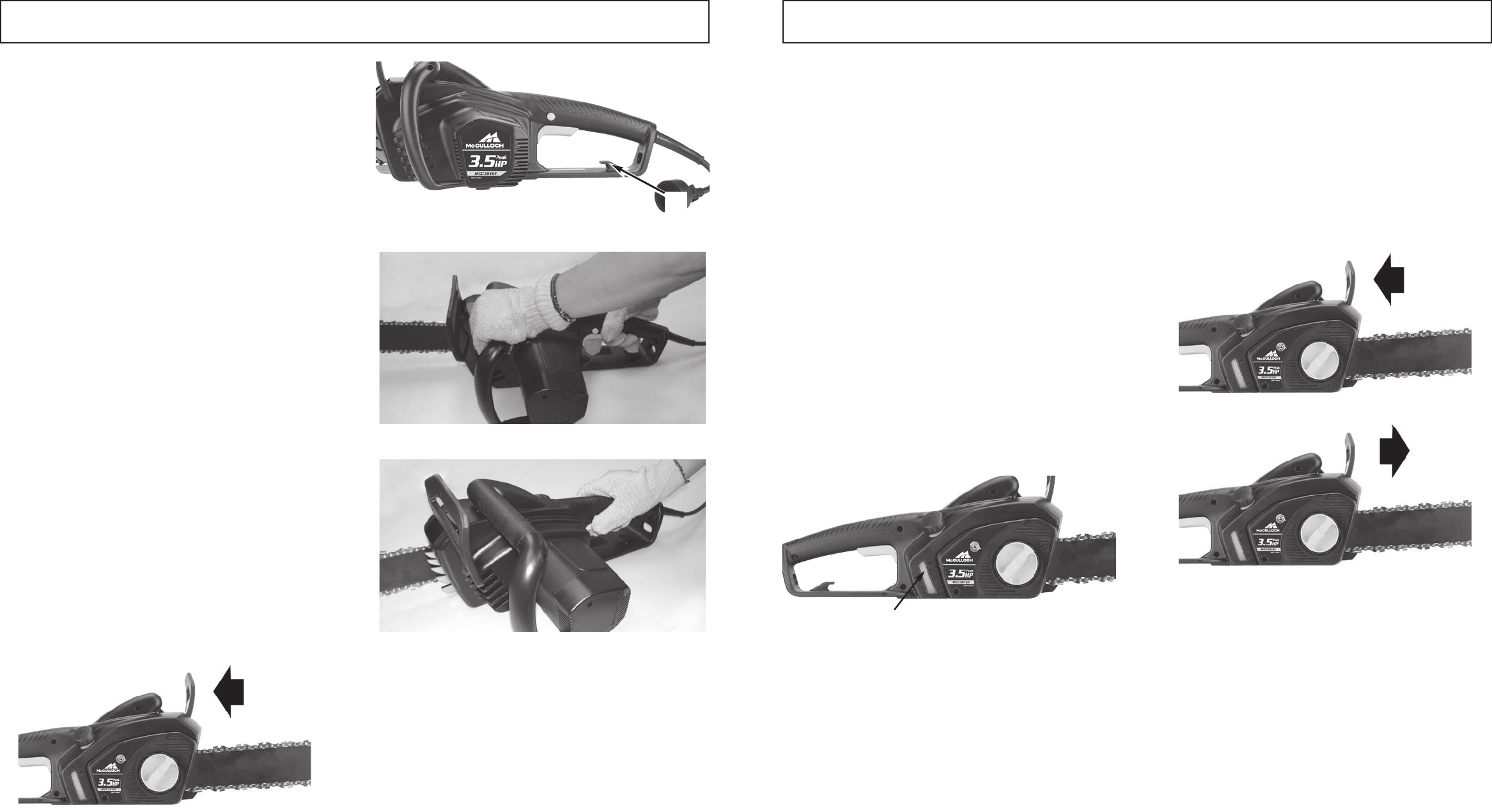
12 13
4 - OPERATING INSTRUCTIONS
4-1. TO START SAW
1. Make sure the CHAIN BRAKE
®
IS DISENGAGED.The
motor will not start if the CHAIN BRAKE
®
is in the
ENGAGED position. Disengage the CHAIN BRAKE
®
by pulling backward toward the motor (Figure 4-1A).
WARNING
Ensure the extension cord is of the proper size and type for
your saw.
2. An extension cord retainer (A) (Fig. 4-1B) is built into
the rear handle that prevents the extension cord from
pulling out of the handle. To use this feature, simply
double the extension cord, about a foot from the end,
and insert it through the hole at the end of the handle.
Hook the loop formed by doubling the cord over the
tab. Gently tug on the cord to ensure that it is firmly
retained in the saws handle. Plug the receptacle end
of the extension cord into the tool’s power supply cord.
WARNING
Make sure the extension cord does not come in contact
with the guide bar and saw chain.
3. Grip the saw with both hands,
left hand holding the
front handle (DO NOT HOLD CHAIN BRAKE
®
) and
the right hand holding the rear handle. Thumbs and
fingers should encircle both handles (Figure 4-1C).
4. With your RIGHT THUMB, depress the LOCK/OFF
button on the top of the rear handle, and at the
same time squeeze the trigger. To stop the saw,
release the trigger (Figure 4-1D).
NOTE: It is not necessary to maintain pressure on the
LOCK/OFF button once the trigger is squeezed and the
motor is running. The LOCK/OFF button is a safety device
to avoid accidental starting.
4-2.TO STOP MOTOR
The saw motor will automatically stop when the trigger is
released. The LOCK/OFF button will have to be depressed
and the trigger squeezed to restart the motor.
4 - OPERATING INSTRUCTIONS
4-3. CHAIN AND BAR LUBRICATION
Adequate lubrication of the saw chain during cutting oper-
ations is essential to minimize friction with the guide bar.
Your chain saw is equipped with an automatic oiler system.
The oiler automatically delivers the proper amount of oil to
the bar and chain. There is no flow adjustment.
The oil tank level can be checked in the inspection slot (A)
provided on the right side of the saw. Tank is full when oil is
at the top of the slot (Figure 4-3A).
CAUTION
Never starve the bar and chain of lubrication oil. Running
the saw DRY or with TOO LITTLE OIL will decrease cutting
efficiency, shorten chain saw life, and cause rapid dulling of
the chain and excessive wear of the bar from overheating.
Too little is evidenced by smoke or bar discoloration.
NOTE: The saw chain stretches during use, particularly
when it is new, and occasional adjustment will be needed.
A new chain requires more frequent adjustment during the
break-in period. This is normal. See Section 3-4, Saw
Chain Tension Adjustment instructions.
WARNING / CAUTION
A loose chain can jump off the bar while you are cutting, as
well as wear the bar and chain. A chain that is too tight can
damage the saw. Either situation, chain too loose or too
tight, could cause serious personal injury.
4-4. CHAIN BRAKE
®
/ HAND GUARD
This McCulloch chain saw is equipped with chain
brake/hand guard.
The Hand Guard protects your left hand in the event it slips
off the front handle.
The CHAIN BRAKE
®
is a safety feature which is activated
if pressure is applied against the guard or when, in the
event of kickback, the operator’s hand strikes the lever.
When the CHAIN BRAKE
®
is activated, chain movement
abruptly stops and the power supply to the motor is imme-
diately cut off.
The purpose of the CHAIN BRAKE
®
is to reduce the possi-
bility of injury due to kickback. The CHAIN BRAKE
®
cannot,
however, provide the measure of intended protection if the
saw is carelessly operated.
The CHAIN BRAKE
®
is disengaged (chain can move) when
the brake is pulled back and locked. This is the normal run-
ning position (Figure 4-4A).
The CHAIN BRAKE
®
is engaged (chain cannot move) when
the brake is in forward position (Figure 4-4B).
NOTE: The motor will not start if the CHAIN BRAKE
®
is in
the engaged position.
CAUTION
The CHAIN BRAKE
®
should not be used for starting and
stopping the saw during normal operation.
4-1A
4-1B
A
4-1C
4-1D
4-3A
A
4-4A
4-4B


















